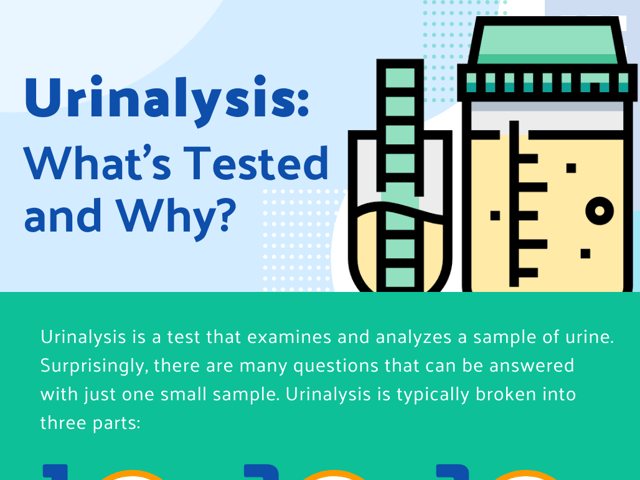
Urinalysis: What’s Tested and Why?
Urinalysis is a test that examines and analyzes a sample of urine. Surprisingly, there are many questions that can be answered with just one small sample. Urinalysis is typically broken into three parts: a visual examination of the urine sample, a chemical analysis (also called a dipstick test), and a microscopic analysis.
Visual Examination
In the visual examination of the urine sample, the main concerns are the color and/or cloudiness of the urine. Everyone is aware of the “normal” color of urine, but a darker color may indicate dehydration or other particles in the urine. Blood can also be seen in the urine, which could indicate kidney damage, infection, or cancer, and require a follow-up. Cloudy urine usually indicates an infection that also requires additional testing.
Chemical Analysis
The chemical analysis of the urine is referred to as a dipstick test because a plastic dipstick is used to test for the presence or absence of certain elements. The main elements that are inspected are the urine’s pH or acidity and the presence of protein, glucose, white blood cells, bilirubin, and blood. Abnormal pH or the presence of protein or glucose is usually a sign of a kidney disorder, while white blood cells in the urine are most likely the result of an infection. Bilirubin in the urine may be caused by liver disease.
Microscopic Analysis
The microscopic analysis of the urine will look for red blood cells, white blood cells, bacteria, and crystals that cannot be seen visually or on the dipstick test. We’ve already mentioned the potential causes for blood cells. Bacteria in the urine most likely means there is an infection in the body. Crystals are formed from chemicals in the urine, and too many crystals can lead to a stone.
In summary, a urinalysis test can be a quick and easy way to run basic tests for many potential disorders. Most abnormal results will require a follow-up. Additionally, there are more specific tests that can be run with the same specimen to determine the presence or absence of certain substances.

Keep Reading

National Council Licensure Examination-Practical Nurse Blog
How Long Should I Study for the NCLEX-PN?
For aspiring nurses, the NCLEX-PN is a critical hurdle on the path to b…

National Council Licensure Examination-Practical Nurse Blog
How to Become an LPN
Would you like to average $30 dollars per hour in a rewarding full-time…

National Council Licensure Examination-Practical Nurse Blog
What Is the Difference between Dementia and Alzheimer’s?
Many people use the terms dementia and Alzheimer’s interchangeably, but…